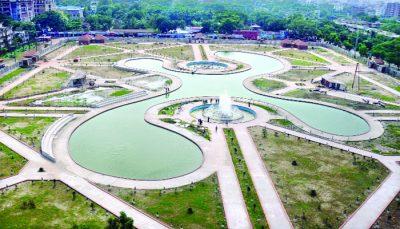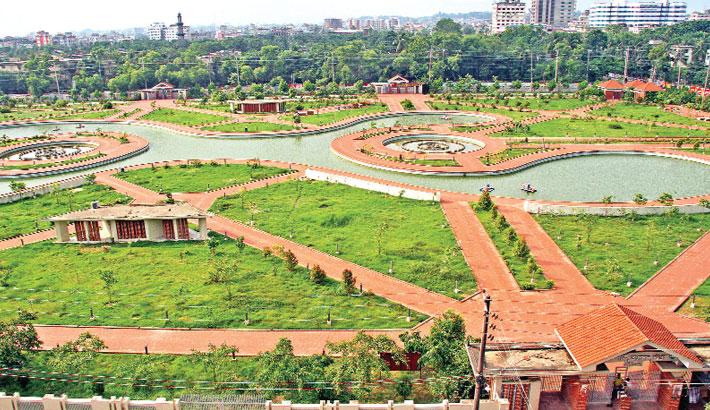Jamburi Park (also spelled as Jamboree park) is an urban park located in the Agrabad area (downtown commercial and financial area) of Chittagong. The area of the park has been for a long time an abandoned land used by locals to grow vegetables, illegally erect constructed makeshift shops, or to engage in illegal activities. (1, 3) In 2015, the Public Works Department (PWD), a unit under the Ministry of Housing and Public Works, a pioneer in the construction arena of Bangladesh, decided to take back the land and transform it into a park with the purpose of capitalizing open spaces as well as creating a functional green area (1). Since there aren't many open places in Chittagong, PWD wanted to give the residents a place to get some fresh air (1). Standing at 8.55 acres, the park was designed with trees belonging to 65 species as well as a 50,000 square-foot pool-like water feature (a lake) in the middle, 8,000 meters of walkways, two public restrooms, and two maintenance and electrical blocks. The lake's shore is bordered by a pathway that is ideal for walking and fitness. The green elements are displayed on both shores of the lake and they consist of various fruit, forest, and flower trees as well as grass. (3, 5, 6)
Overview
Nature-based solution
- Blue infrastructure
- Lakes/ponds
- Parks and urban forests
- Pocket parks/neighbourhood green spaces
Key challenges
- Environmental quality
- Waste management
- Green space, habitats and biodiversity (SDG 15)
- Green space creation and/or management
- Water management (SDG 6)
- Flood protection
- Health and well-being (SDG 3)
- Enabling opportunities for physical activity
Focus
Project objectives
Implementation activities
Biodiversity conservation or restoration-focused activities
Biodiversity conservation:
- Protect and enhance urban habitats
- Create new habitats
- Other
Main beneficiaries
- National-level government
- Citizens or community groups
- Young people and children
Governance
Management set-up
- Government-led
Type of initiating organisation
- National government
Participatory approaches/ community involvement
- Unknown
Details on the roles of the organisations involved in the project
Project implemented in response to ...
Financing
Total cost
Source(s) of funding
- Public national budget
Type of funding
- Direct funding (grants, subsidies, or self-financed projects by private entities)
Non-financial contribution
Impacts and Monitoring
Environmental impacts
- Green space and habitat
- Increased green space area
- Increased number of species present
- Enhanced support of pollination
Economic impacts
- Unknown
Socio-cultural impacts
- Social justice and cohesion
- Improved access to urban green space
- Increased opportunities for social interaction
- Safety
- Increased perception of safety
Type of reported impacts
Presence of formal monitoring system
Presence of indicators used in reporting
Presence of monitoring/ evaluation reports
Availability of a web-based monitoring tool
References
2. Dhaka tribune. (n.d.) In pictures: Chittagong Jamboree playground is now a lit park. URL: Source link (Accessed on 09 February, 2023).
3. Kaler Kantho. (2018).নজরকাড়া জাম্বুরি পার্ক. URL: Source link (Accessed on 09 February, 2023).
4. Daily Nayadiganta (2018). উদ্বোধনের অপোয় চট্টগ্রামের জাম্বুরি পার্ক. URL: Source link (Accessed on 09 February, 2023).
5. Paathok (2018) নতুন বিনোদন কেন্দ্র জাম্বুরি পার্কে’র আনুষ্ঠানিক উদ্বোধন. URL: Source link (Accessed on 09 February, 2023).
6. Amader Orthoneeti (2018). উন্নত বিশ্বের আদলে চট্টগ্রামের জাম্বুরি পার্ক. URL: Source link (Accessed on 09 February, 2023).
7. Jafrin, M. Developing a Data-Driven Strategy and Guideline to Increase Per Capita Open Space and Relative Accessibility in Chittagong City. Sustainability 2022, 14, 9828. URL: Source link (Accessed March 04, 2023)




